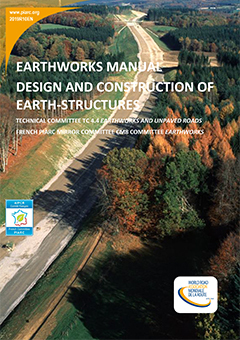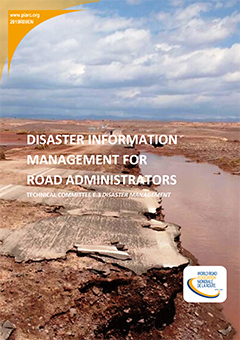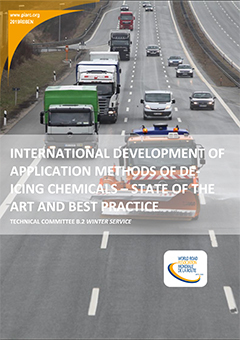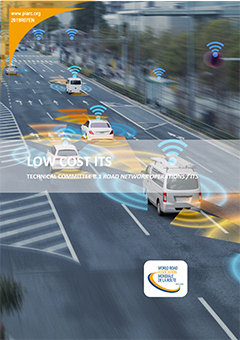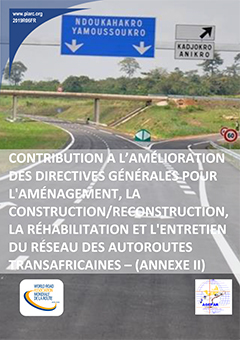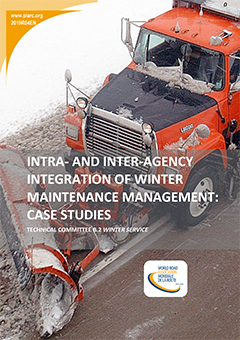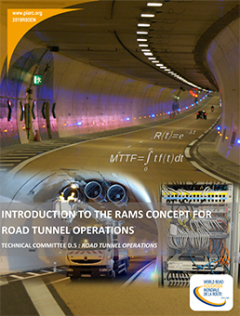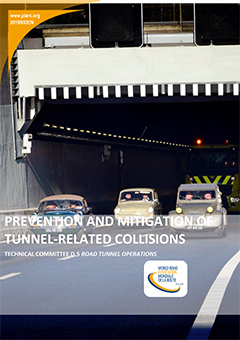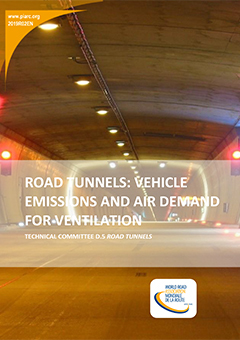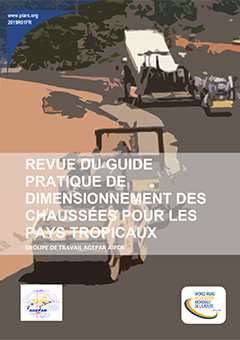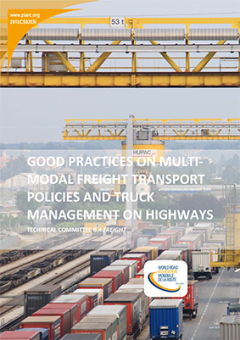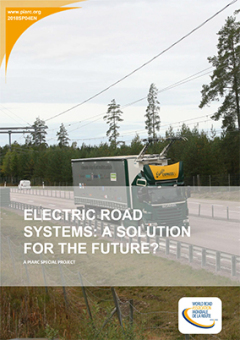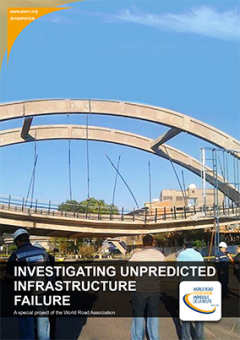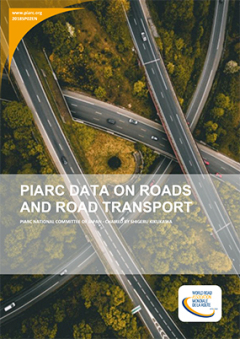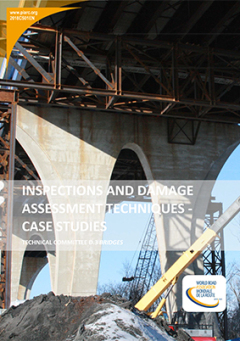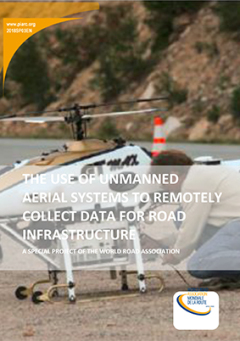Discover the new PIARC publications!
Discover the first publications of the 2016 - 2019 work cycle of the World Road Association (PIARC). They are available in one or more of the Association's three working languages, French, English and Spanish, and are published after a meticulous validation and quality control exercise.
Stay tuned, many more will be available soon!
Earthworks Manual
The Manual takes into account the different PIARC technical reports produced in previous sessions by integrating them into the extended data of the current session.
The earthworks construction process produces earth-structures: cuts, fills or embankments, pavement support structures meeting specifications for stability, deformation, load-bearing capacity, hydraulic or other.
A specific chapter is devoted to environmental aspects and proposals for actions to contribute to sustainable development in the field of earthworks.
Disaster Information Management for Road Administrators
This report identified "Disaster Information Management" and "Disaster Management with the Public" as current important technologies to manage disasters with adapting to the society changes. The report highlighted some case studies for the best practices for improving the management technologies in disaster situations. Therefore, this information would be very beneficial not only to the countries with the disaster risk, but also to the countries, especially to the LMICs, for improving the structures in management of disastrous situation.
This report also highlights the fact that these identified management technologies has limitations for applying to the countries because risk-awareness is a key influence on the ability of a country to prepare for managing disasters. Therefore, careful investigation of the risk awareness of the society is needed for their transferability and applicability in advance.
International Development of Application Methods of De-icing Chemicals - State of the Art and Best Practice
The PIARC technical committee Winter Service conducted a survey of winter maintenance in the countries represented in PIARC. Scopes were winter maintenance standards, type of de-icing chemicals and application methods. Besides current development also research projects and guidelines have been compiled.
The paper sums up the most important findings and analyses, the different winter maintenance standards and techniques. The paper discusses also open questions such as the limit of brine at low temperatures and gives an outlook on future developments.
Low Cost ITS
The objective of this report is to perform an in-depth investigation of the Low cost ITS concept to clarify its definition and investigate all related aspects: service areas, stakeholders and value chain, business model and costs, system architecture, quality of service, system resilience, legal aspects, privacy and standardisation. On these different aspects, whenever possible the comparison between traditional and low-cost approaches is addressed.
For this document to be more than a theoretical guide we have tried to anchor it in reality by illustrating it with twenty case studies that are available in a separate booklet.
Contribution to the improvement of the general guidelines for the development, construction/reconstruction, rehabilitation and maintenance of the Trans-African Highway network - (Annex II)
This report is a review, for the purpose of improvement, of Annex II entitled "General Guidelines for the Planning, Construction/Reconstruction, Rehabilitation and Maintenance of the Transfrician Highway Network" of the African Union Intergovernmental Agreement for the Harmonization of Norms and Standards on the Trans-African Highway Network.
- Consult the technical report (in French)
Intra- and Inter-Agency Integration of Winter Maintenance Management: Case Studies
PIARC Technical Committee B.2, "Winter Maintenance," working group B.2.1., "Transportation Management during Winter Events," was tasked with identifying noteworthy examples of cooperation within and between agencies responsible for winter maintenance management.
The working group asked PIARC members to submit by email short case studies demonstrating management integration efforts occurring at the intra-agency level (that is, within one agency) or at the inter-agency level (that is, between agencies, or across a regional or national border). The working group provided a template for this purpose.
Introduction to the RAMS Concept for Road Tunnel Operation
The aim of this report is to provide an initial introduction to the RAMS concept. It first explains why and when the concept should be applied within the context of road tunnel operation and then goes on to describe how the concept can be applied by using the standard EN 50126 as a basis.
The report also gives an overview of existing RAMS-based standards/guidelines around the world and provides the results of an international survey conducted by the working group on how road tunnel operators currently take into account reliability, availability, maintainability and safety aspects in their respective countries.
Prevention and Mitigation of Tunnel-Related Collisions
This report presents and recommends possible organizational and technical measures one can implement to lower the probability (prevention) or the mechanical consequences (mitigation) of tunnel related collisions, that is, collisions in which the specific characteristics of a tunnel play a role in either the cause or the effect.
Road Tunnels: Vehicle Emissions and Air Demand for Ventilation
Data collection and methodologies to derive fresh-air volumes are similar to those described in PIARC's previous reports concerning emission estimations for ventilation design. However, the emission rates found in older reports are outdated. Vehicle legislation has enforced more stringent emission rates since their publication, and vehicle technology has rapidly advanced, resulting in lower emissions.
This report completely replaces the previous report on vehicle emissions and fresh-air demand published by PIARC in 2012. Previously reported emissions factors are outdated and should not be used for calculating the fresh-air demand in road tunnel ventilation design.
Practical Guide to Pavement Design for Tropical Countries (in French only)
This report prepared by a joint PIARC/AGEPAR study group makes a set of recommendations for updating the 1984 guide and establishing new technical rules for pavement design for French-speaking countries in sub-Saharan Africa.
- Consult the technical report (in French)
Good Practices on Multi-Modal Freight Transport Policies and Truck Management on Highways
Well-functioning logistics and freight transport systems are crucial for a prosperous economy and a thriving society. The World Road Association/PIARC B4 Freight Technical Committee examines issues surrounding multi-modal and road cargo transport and reviews practices related to truck management and energy-efficient movement of freight.
Electric road systems: a solution for the future?
It is looking increasing likely that electric vehicles will play a major role in the future of road transport. While commercial electric vehicles exist their uptake has been limited due to high purchase costs, limited battery range, and a lack of charging convenience. Furthermore, while developments are underway, electric and hybrid drive trains are yet to be efficiently integrated with heavy goods vehicles (HGVs). A novel way to overcome such challenges are Electric Road Systems; a branch of technologies that allow vehicles to charge while in motion. Limited information exists regarding the comparative performance of ERS solutions, market readiness, costs, and implementation issues. To this end, the World Road Association (PIARC) commissioned TRL to undertake a state-of-the-art review and feasibility study of ERS concepts; focusing on ERS implementation from the perspective of a road administration.
Investigating Unpredicted Infrastructure Failure
This report is an outcome of PIARC mechanism for Special Projects, which is PIARC instrument to respond quickly to emerging issues for PIARC member countries.
This report provides a review of 15 Unpredicted Infrastructure Failure (UIF) case studies that have been collated from around the world. For the purposes of the report UIF is defined as:
instances where failure1 occurs on an asset that is considered in good condition and is well maintained
The case study data from our interviews and online surveys have been assessed to identify lessons that can be utilised by road administrators when preparing for, responding to and recovering from UIF. Our results and conclusions have been categorised against the incident management cycle which is made up of four key stages; Mitigation, Preparedness, Response and Recovery.
Establishment of PIARC Databook of Road and Road Transport (2014-2018)
Currently road administrations of many countries on austerities has to tackle some difficult issues: investing on extension of road network, maintenance and rehabilitation of existing aged roads, prompt recovery of road operation from the damage caused by large-scale disasters, and creation of safe road space.
- Coming soon
Inspections and Damage Assessment Techniques - Case Studies
The PIARC TC D.3 Bridges Technical Committee is publishing a worldwide compilation of case studies as examples for bridge owners in making critical decisions to ensure the safety of the traveling public during a bridge incident caused by damage and deterioration. This case study compilation has 28 worldwide case studies received from 15 unique countries.
These case studies provide examples of incidents where owners discovered damage or deterioration under two main circumstances. Firstly, damage or deterioration resulting over longer periods of time, and secondly damage or deterioration appearing instantaneously.
The Use of Unmanned Aerial Systems for Road Infrastructure
From Canada to Tanzania, transportation agencies are using unmanned aerial systems (UASs), also known as drones, to collect data, design and construct road infrastructure, inspect bridges, monitor roads for avalanche and mudslide dangers, identify flood damage risks in urban areas, reconstruct crash scenes, and monitor traffic and road conditions.
